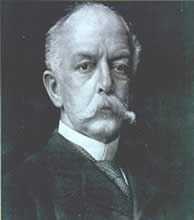Charles McBurney (surgeon)

Charles Heber McBurney, MD (17 February 1845, Roxbury, Massachusetts – 7 November 1913, Brookline, Massachusetts) was an American surgeon, well known for describing McBurney's point in appendicitis.
Biography

Charles McBurney was born in 1845. He graduated in the arts from Harvard College in 1866, and qualified in medicine at the College of Physicians and Surgeons of Columbia University in New York with an M.D. in 1870. He trained further in Europe for 2 years, and started practice in New York in 1873. He became assistant surgeon to the Bellevue Hospital in 1880, and surgeon-in-chief of the Roosevelt Hospital in 1888. Here he did his most famous work on appendicitis, presenting his report on operative management to the New York Surgical Society in 1889.[1] He described the point of greatest tenderness in appendicitis, which is now known as McBurney's point. He was professor of surgery from 1889 to 1907, and thereafter became emeritus professor of surgery. He continued to advance the treatment of appendicitis,[2] and in 1894 he described the incision that he used;[3] although the incision had previously been described by Louis L. MacArthur, it became known as McBurney's incision.[4]
In addition to his work on appendicitis, McBurney also published papers on the treatment of pyloric stenosis,[5] management of shoulder dislocation with fracture of the humerus,[6] and gallstone disease.[7] He also introduced the use of rubber gloves during his operations to improve aseptic technique, following the lead of William Halsted.[8]
He was a keen hunter and fisherman, and died in 1913 on a hunting trip in Massachusetts.[9]
His grandson was American archaeologist Charles McBurney and his great-grandson is English actor, writer and director Simon McBurney.
References
- ↑ McBurney C. Experience with early operative interference in cases of disease of the vermiform appendix. NY Med J 1889:50:676–684.
- ↑ McBurney C (April 1891). "II. The Indications for Early Laparotomy in Appendicitis". Ann. Surg. 13 (4): 233–54. doi:10.1097/00000658-189101000-00061. PMC 1428594. PMID 17859535. Retrieved 2009-02-08.
- ↑ McBurney C (July 1894). "IV. The Incision Made in the Abdominal Wall in Cases of Appendicitis, with a Description of a New Method of Operating". Ann. Surg. 20 (1): 38–43. doi:10.1097/00000658-189407000-00004. PMC 1493708. PMID 17860070. Retrieved 2009-02-08.
- ↑ Steven H. Yale, Kenneth A. Musana. Charles Heber McBurney (1845-1913). Clin Med Res 2005 August; 3(3): 187-189
- ↑ McBurney C (May 1886). "II. Operations for Pyloric Stenosis". Ann. Surg. 3 (5): 372–80. doi:10.1097/00000658-188603000-00031. PMC 1431502. PMID 17856064. Retrieved 2009-02-08.
- ↑ McBurney C (April 1894). "II. Dislocation of the Humerus Complicated by Fracture at or near the Surgical Neck, with a New Method of Reduction". Ann. Surg. 19 (4): 399–415. doi:10.1097/00000658-189401000-00038. PMC 1493596. PMID 17860028. Retrieved 2009-02-08.
- ↑ McBurney C (October 1898). "VIII. Removal of Biliary Calculi from the Common Duct by the Duodenal Route". Ann. Surg. 28 (4): 481–6. PMC 1427193. PMID 17860638. Retrieved 2009-02-08.
- ↑ McBurney C (July 1898). "IV. The Use of Rubber Gloves in Operative Surgery". Ann. Surg. 28 (1): 108–19. PMC 1427096. PMID 17860601. Retrieved 2009-02-08.
- ↑ Charles McBurney at Who Named It?